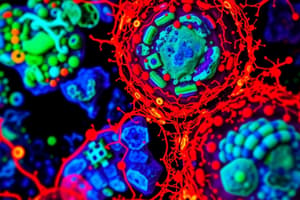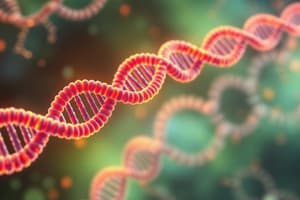Podcast
Questions and Answers
What is the main purpose of the Electron Transport Chain (ETC) in cellular respiration?
What is the main purpose of the Electron Transport Chain (ETC) in cellular respiration?
- To use NADH and FADH2 to concentrate H+ protons in the intermembrane space (correct)
- To convert pyruvate into Acetyl-CoA
- To generate NADH and FADH2 from the TCA cycle
- To produce ATP directly from the oxidation of glucose
Which molecule is produced during the conversion of pyruvate to Acetyl-CoA?
Which molecule is produced during the conversion of pyruvate to Acetyl-CoA?
- CO2
- FADH2
- ATP
- NADH (correct)
What is the primary energy source for the Electron Transport Chain (ETC)?
What is the primary energy source for the Electron Transport Chain (ETC)?
- Pyruvate
- Glucose
- ATP
- NADH and FADH2 (correct)
What is the role of beta oxidation in cellular respiration?
What is the role of beta oxidation in cellular respiration?
What is the function of Complex I in the electron transport chain?
What is the function of Complex I in the electron transport chain?
What is the role of Coenzyme Q (CoQ) in the electron transport chain?
What is the role of Coenzyme Q (CoQ) in the electron transport chain?
What is the function of Complex II in the electron transport chain?
What is the function of Complex II in the electron transport chain?
What is the function of Complex III in the electron transport chain?
What is the function of Complex III in the electron transport chain?
What is the function of Complex IV in the electron transport chain?
What is the function of Complex IV in the electron transport chain?
Where are the structural changes in Complex I directing H+ to move through translocation half-channels?
Where are the structural changes in Complex I directing H+ to move through translocation half-channels?
What forms supramolecular assemblies or supercomplexes in the electron transport chain?
What forms supramolecular assemblies or supercomplexes in the electron transport chain?
What is the power source for the ATP synthase to convert H+ gradient into ATP?
What is the power source for the ATP synthase to convert H+ gradient into ATP?
Flashcards are hidden until you start studying
Study Notes
Electron Transport Chain (ETC)
- The main purpose of the ETC is to generate ATP during cellular respiration.
- The primary energy source for the ETC is the proton gradient generated by the transfer of electrons.
Conversion of Pyruvate to Acetyl-CoA
- The molecule produced during the conversion of pyruvate to Acetyl-CoA is CO2.
Beta Oxidation
- The role of beta oxidation in cellular respiration is to break down fatty acids into Acetyl-CoA.
Complexes of the Electron Transport Chain
- Complex I: also known as NADH dehydrogenase, it transfers electrons from NADH to CoQ and generates a proton gradient.
- Complex II: also known as succinate dehydrogenase, it transfers electrons from succinate to CoQ and does not generate a proton gradient.
- Complex III: also known as cytochrome b-c1 complex, it transfers electrons from CoQ to cytochrome c and generates a proton gradient.
- Complex IV: also known as cytochrome c oxidase, it transfers electrons from cytochrome c to oxygen and generates a proton gradient.
Proton Translocation
- The structural changes in Complex I direct H+ to move through translocation half-channels.
Supramolecular Assemblies
- Supramolecular assemblies or supercomplexes are formed by the complexes of the electron transport chain.
ATP Synthesis
- The power source for the ATP synthase to convert H+ gradient into ATP is the proton gradient generated by the ETC.
Studying That Suits You
Use AI to generate personalized quizzes and flashcards to suit your learning preferences.




